‘Come Hell or High Water’–Rangers Caught in Urgent Fight, Flight to Save One of Their Own It was June 1970, more than a month into the U.S. campaign in Cambodia and the expansion of the war in Vietnam. And sure enough, there they were.
I looked out the door of the Huey helicopter into the orange, yellow, and purple fan rays of the sunset over Southeast Asia. The air was cool up here—about 70 degrees compared to the 112-degree heat just 2,000 feet below us.
It was June 1970, more than a month into the U.S. campaign in Cambodia and the expansion of the war in Vietnam. The view, along with the noise from the prop wash and jet engine, was quite soothing—a paradox to the mission at hand.
Everyone on our team was dressed in fatigues, either tiger or leaf pattern, and we’d treated our exposed skin, including our faces, in light or dark green, brown, or black.

A helicopter returns from a scouting mission in Vietnam. The purpose of these missions was to get a layout of the land and map the area before small special operations teams were inserted. Photo courtesy of the author.
The door gunner interrupted us from our reverie as he spoke into the mic on his headset. He looked over at us and gave us two palms, 10 fingers up, to signal we were 10 minutes out.
My team members’ relaxed expressions revealed nothing. They might have been watching a piano recital. Everyone checked their weapons and gear one last time as we approached our area of operation. The pilot began a slow bank and descent into the jungle.
I sat on the port side of the bird, feet on the skids, looking down now as the cool breeze rushed past. As I checked the area below the canopy for movement, I thought I saw something. I nudged Fisher seated next to me. He saw it, too, but apparently, no one else did.
We sounded off, alerting the rest of the bird and directing everyone’s vision to where we looked. Sure enough, there they were: members of the North Vietnamese Army in khakis walking around relaxed, guns slung over their shoulders. They looked up at us with the air of someone strolling along the beach who’d spotted a breaching whale—an anomaly, but not a threat.
We were now between 900 and 1,200 feet above them, but they made no movement to prepare their weapons or take potshots at us. The pilot made one slow turn, moving away from them but not in such a way as to be too obvious, and began an ascent to about 3,000 feet.
As the pilot moved away from the insertion/infiltration location, we overheard snippets of a heated argument that had broken out between him and the commander who’d wanted us inserted yesterday.
“You’re going to be inserted, come hell or high water,” the commander said.
The pilot and our team leader tried to tactfully state that our five-man Ranger team, if inserted into a platoon-sized group of North Vietnamese waiting on the ground, would be decimated in a fusillade of gunfire.
The colonel answered by asking if they knew who they were addressing.
In the end, our chopper pilot’s tact, strategic knowledge, and experience prevailed, and we ended up back at Fire Support Base David for the night for another look at the maps and a discussion about what had happened that day. After all, the colonel had said he was going to get us inserted come hell or high water.
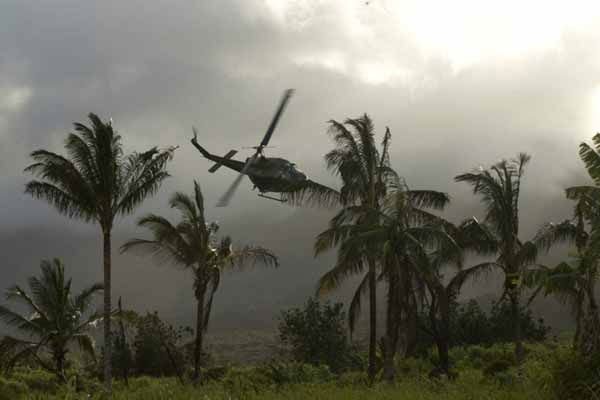
A helicopter in Vietnam. Photo courtesy of the author.
The next morning, my mouth felt like water buffaloes had used it for a latrine. It had been a rough night of rowdy base camp frolicking. Fisher and Tex stood behind me with their mirrors up checking their camo. We gave each other our usual “middle finger salute.”
Omer Carson was there, too, but he didn’t feel well and wasn’t putting on his camo. He was 18 and looked it with his red hair, freckles, and small frame, belying the fact that he was a battled-hardened Ranger.
Our team leader, Partin, was nervous. About five-foot-10 and a buck 60, Partin was a staff sergeant and honor graduate of stateside Ranger school, but this was his first mission on his own. It didn’t help that it was “across the fence” in Cambodia, a focal point at this juncture of the war. The rest of us were experienced, with at least 10 missions each or more.
Today’s mission would have two different members from the day before, including Smitty, a large man at about six-foot-three and 230 pounds, and one surly Okie, tough and all business in a firefight. Tex was also from Oklahoma, a rumored lady’s man who was quiet until he had a few drinks, and the best point man on our teams.
Award-Winning Journalism in Your Inbox
We all felt the weight of what we’d seen on the overflight the day before. We had no illusion as to whether the enemy was present. As we readied, we did a “bounce test” for noise, checked each other’s equipment, thoroughly applied camouflage makeup, did two communications checks, and rolled our boonie hats up and tucked them into our tiger or leaf-patterned fatigues. Just then the mule—a four-wheel-drive utility vehicle—sped in to pick us up and take us to the flight line.
We hurried now. The urgency of destiny was thrust upon us with no apologies. We didn’t think much about what could happen to us. It was best to keep yourself occupied and make sure you did the job you were trained for and not screw up any part of it because every man’s life next to you in small units depended on it. In the event you couldn’t do your job, everyone was cross-trained to pick up the slack and do whatever was necessary.
The high-pitched whine of the jet turbine engine on the Huey and the whop-whop-whop of the rotors grew into a screaming, deafening pitch, and the prop wash threatened to blow our boonie hats out of our camo jackets.
We ran half-crouched toward the Huey, split into port and starboard elements to balance it, and plopped down almost simultaneously. After a final check, we were airborne, streaking down the strip at 125 knots as the pilot tried to pick up speed inside “friendly territory” and the runway flashed beneath us.
At about 1,500 feet, the chatter started over the radio. “M-JAG-SkReq … two- Nhniner … SPLugg SKreek over?”
The pilot shook his head and threw a hand up in the air. “Confirm? … Something?”
After a brief conversation that sounded to us like gibberish, the pilot turned the bird around. Back on the ground, he motioned us over. We knew him well—he was savvy and reliable. He told us that the colonel had gotten some birds to fly recon over the area again and, on his own, had come up with another infiltration/insertion site about 2,000 meters from the original site.
We all looked at each other with knowing glances, shaking our heads. A late-day insertion was usually not a great idea, especially when the enemy had already seen and heard several birds in their area.
We waited all day, passing the time by playing mumblety-peg. Bored, we threw knives at a stump and then each other. Two guys got into a fistfight, and nobody moved or said anything as they practically fell at our feet. We just watched as they beat each other’s asses. Fisher and I talked about how pretty the fall would be in Kentucky and Tennessee for fishing and hunting, although neither of us was really thinking about that right now.
Finally, it was time to camo up again. We loaded our gear onto the mule for the second time that day, and off we went.
The view from the sky was just as beautiful as the night before, a mesmerizing kaleidoscope of yellows, burnt orange, and shades of purple. This could be the last sunset I ever see, I thought. I tried to distract myself, to get my mind to a calm place—and settled on diving a reef in the Caribbean, blowing bubbles.
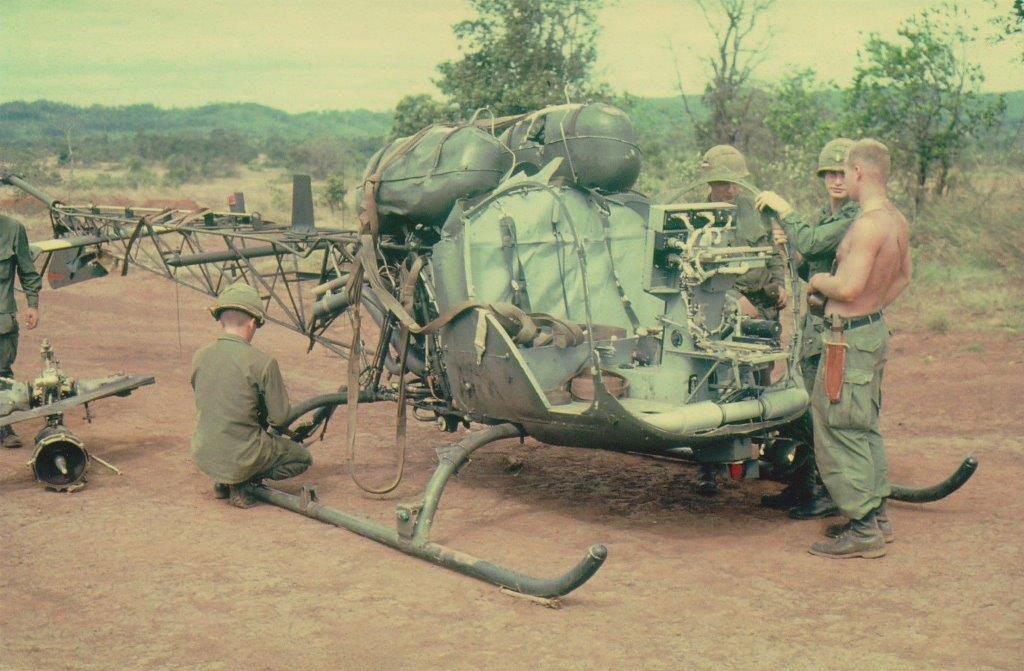
A broken Bell OH-13 Sioux used to scout ahead of Huey formations.
Photo courtesy of the author.
I fiddled with the radio, looked at our codes and asset list to check for Medevac birds on standby. Then it was time.
The door gunner gave us two palms, fingers up, and mouthed: 10 mikes out … get ready …
The team leader was now in the cockpit talking directly to the pilot and comparing his map with the one on the pilot’s kneeboard. He gave us the “go” signal, one thumb up. With only one low pass, we started easing ourselves further out onto the skids, balancing on our knees as he came in fast.
The whole chopper was nose high for an instant, then fell back to allow us our quick, choreographed movements. We jumped in unison so as not to cause the bird to pitch and yaw for his takeoff.
In less than five seconds, we gathered ourselves, threw our equipment on our backs, and ran as fast as we could toward the tree line as the bird became a low hum in the distance.
Partin, our team leader, gave us the signal to halt, and we all faced out, looking intently for anything unusual while trying to stifle the sound of our panting. We waited for 15 minutes, then moved quickly, each man checking his sector and trying not to make a sound—not even the snap of a twig underfoot—as we moved through the jungle.
In the fading light, we found a game trail that allowed us to move more rapidly. Tex gave us the halt sign, and we fanned out, dropping low and checking our sectors again. I called a situation report in code to our relay on a mountaintop in Vietnam: We’d inserted successfully, no incident, moving en route to objective.
We moved forward with purpose. We had to get set up for the night before darkness fell—a darkness so black it was like someone kicked over a bucket of tar. Partin gave a “circle up” signal. We’d all noticed footprints on the way in. At best, they were six hours old, maybe fresher.
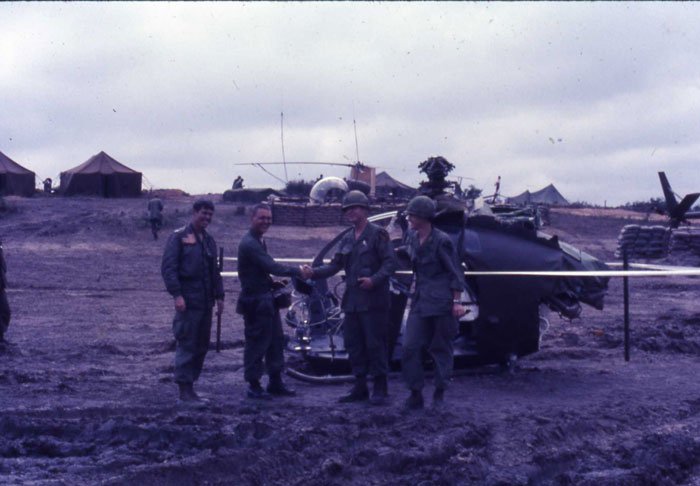
A bird is recovered and returned to its unit after being shot down in Vietnam. Photo courtesy of the author.
Partin pointed to positions for us to move into, and we quickly, quietly moved into our night defensive formation. I was on the radio giving another situation report, which meant I’d be the first to eat. I got out a long-range patrol ration while sending my second coded message to our tactical ops center.
As I watched the team set up for the night halt, I thought I saw something moving beyond them. But try as I might, I could not make out anything in the dim light. Still, the hair stood up on the back of my neck. Silence at this time of day was very atypical.
I strained my eyes and ears. Fisher came back into our area with the rest of the team. He was closest to me, followed by Partin. In the waning light, I couldn’t tell who was on the other side of him. There were still no normal night sounds, and that was odd.
As Fisher and I sent hand signals to each other, we heard a metallic “click”—the distinctive sound of an AK-47. Fisher’s expression changed in what looked like slow motion. His smile disappeared and, eyes as big as dinner plates, he mouthed, “NVA.”
We were too late.
B-R-R-P–clack clack clack, B-D-D-O-W-W, came the sound of gunfire. Frump, came the sound of grenades. Whoosh, came the sounds of B40 rockets. Through the smoke, I grabbed the handset off my shoulder and began screaming into it as I cranked squelch.
“Slashing Talon Six, this is 71A, CONTACT, CONTACT, SIX this is SEVEN ONE, CONTACT! Slashing Talon Six, 71 alpha, CONTACT, CONTACT!”
The headset crackled to life just as another long burst ripped through our AO. “Team 71, this is Slashing Talon Six, understand you have contact, over.”
Something hit me hard in the back, like a baseball bat or a large tree limb. I wasn’t sure what it was as I fired to my front with the radio on my shoulder while trying to relay our plight to our tactical operations center. I felt it again—like getting hit by a baseball bat. This time, the impact knocked me from where I sat and spun me like a top.
I could taste copper now, and my mouth filled with globs as thick as molasses. I knew this taste. I had boxed and played football when I was younger.
Fisher and Tex noticed something was wrong and crawled to me as rounds tore up the dirt around us and thuds and sweep-o-ouch sounds flew overhead. They screamed into my ear and I tried to talk. But the thickness clogged my mouth and the last burst had knocked the wind out of me.
I was bleeding badly now from the mouth and nose, and I heard an odd, faint rasping sound when I tried to breathe. It felt like a truck was sitting on my chest, and I struggled to stay conscious and fire my sector.
I was glad to see Fisher’s face in front of mine, and I handed him the handset.
“Did you call it in?”
I nodded. “Thway acknowledged,” I gurgled.
He understood and began transmitting. The infiltration/insertion bird would come back to us even though it was dark—normally, you were on your own until morning.
Fisher laid the radio handset on his shoulder and dug into our rucks for bandages and supplies.
“How bad is it?” I asked him.
“Aw, quit your whinin’. It’s just a scratch,” he said, and it looked like he was smiling.
I saw the large compresses, the 90 MPH tape, and some plastic off a radio bag and knew he was preparing for a “sucking chest wound.”
A little more than a scratch, not quite a gash, in Fisher’s words.
He and Tex were both talking to me through it all now, screaming at me above the cacophony, asking how I was doing as they continued to function as a Ranger team.
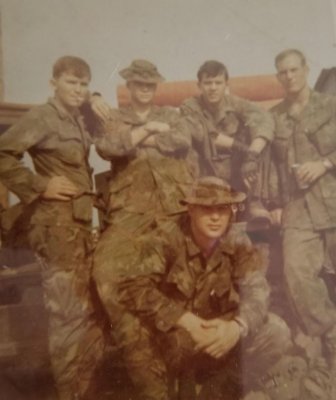
Jim Ketrow kneels in front of his Ranger team. Photo of the author.
They had handed the handset off to Partin, and as they pulled me into a standing position, they asked if I could run. I nodded yes, but didn’t really think I could.
Here came the exfiltration/extraction bird. The chopper pilot has huge brass balls, I thought. He has his fucking lights on.
Above the sound of the bird came the clacking of automatic weapons. Green tracers that looked like laser points went through the fuselage of the bird with a pling pling pling pling sound as they tried to hit the pilot and crew.
But now there were additional weapons firing.
The door gunner on the exfiltration/extraction bird fired at the wood line with his 60, and his red tracers found their mark for suppressive fire in long bursts, raking everything, the bright red laser-like rounds pissing blood into the enemy positions. Other red tracer rounds started coming into the contact area from about 45 degrees above, apparently from a Cobra gunship and a light observation helicopter (pink team).
But somehow through all that, Fisher, talking to me patiently, got me up with my left arm over his shoulder. I felt a stabbing, excruciating pain as he did this; I didn’t know it at the time, but I’d been shot through the left tricep, and shrapnel was lodged in my back.
“Can you fire our sector?” he screamed. He was already moving with me.
I nodded.
“I’ll carry your ruck?”
I still have a good right hand, I thought. All my wounds are on my left side. I began running, running, gasping for air. Then everything started to go black—even the bright lights on the bird and the tracers. Pilots never turn their lights on at night in combat, I thought, and that was the last thing I remember before I awoke with a cool wind blowing across me on the deck of the bird.
Our Journalism Depends on Your Support
“This is Quon Loi,” he shouted into my ear as we landed. Medics ran with a litter toward the bird. They threw me onto it like a sack of shit and ran like hell to a tent, where we were greeted by a doctor and two nurses.
“Son, I can save your life—or not. But it’s up to you to help me,” the doctor said. “This is what you have to do. When I tell you to do it, strain like you are taking a crap, and DO NOT breathe! Do you understand?”
“Yes,” I managed weakly, and globs of blood shot out of my mouth.
The doctor brought out a chest tube and an Emerson bottle. “READY?”
I nodded.
I must have done all right. The next thing I knew I was back on a bird, and we were preparing to land. Two IVs with whole blood were attached to me, along with one of Ringer’s lactate.
Two medics ran out from the 24th Evacuation Hospital and threw me onto a litter. As they ran up the hill to triage, they tripped in all the bloody mud in front of the entrance and dropped me. I fumbled, trying to keep the chest tube from being yanked from my rib cage. I rolled across the ground, fumbling with the surgical tubing attached to the Emerson bottle, and I cussed them fuckers.
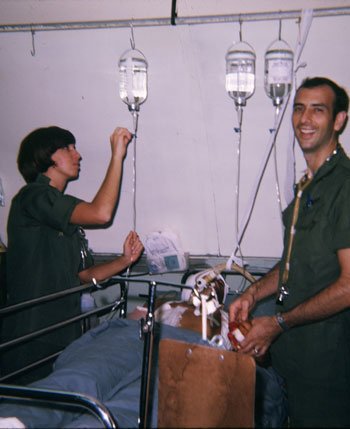
Carol Brown, one of the nurses at the 24th Evacuation Hospital. The author credits her and other nurses and doctors with helping to save his life after he was shot in the chest. Photo courtesy of the author.
They grabbed me and threw me back onto the litter, and continued rushing me into the triage line. If not for my Ranger team petitioning for me, I most likely would have bled to death right there. I was taken inside, where the nurses and doctors were a well-oiled machine of efficiency.
From here, a whole other chapter began, and possibly another story, about how the heroic helicopter and crew medevaced us out, about the nurses and doctors who saved precious minutes.
I spent 25 days at the 24th Evac fighting infections and a fever of 105 degrees. Day and night, nurses sponge-bathed me with alcohol and ice, taking turns with freezing hands to keep me alive. I had four debridement procedures and received 20 milliliters of whole blood and at least an equal amount of Ringer’s lactate.
Two weeks later, Omer Carson, who was supposed to be on this ill-fated mission, was killed when shrapnel from a B40 rocket hit him in the back of his head. He was two weeks shy of his 19th birthday.
This is a tribute to all who were involved in this mission, and others like it, where men and women risked everything, without regard for themselves, to come to this Godforsaken place.
This War Horse reflection was written by Jim Ketrow, edited by Kristin Davis, fact-checked by Jess Rohan, and copy-edited by Mitchell Hansen-Dewar. Abbie Bennett wrote the headlines.





Comments are closed.